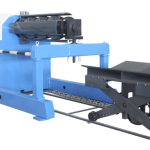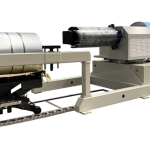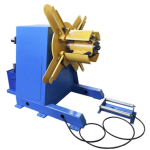Q2: How is the springback effect predicted and compensated for in the design of roll forming tooling, particularly for High-Strength Steel (HSS) profiles?
The springback effect—the elastic recovery of a material after it has been plastically deformed—is the single greatest technical challenge in roll forming design, especially when processing High-Strength Steel (HSS). Prediction and compensation rely on a combination of theoretical models, empirical data, and sophisticated numerical simulation techniques.
1. The Physics of Springback
Springback occurs because not all the stress applied during the bending process causes permanent (plastic) deformation; a portion of the stress remains in the material as residual elastic strain. When the material exits the roll stand, the forming load is removed, and this stored elastic energy is released, causing the part’s final bend angle to open up (increase) and the radius to increase compared to the shape of the tooling.
A. Springback Angle (\(\Delta \alpha\))
The difference between the die angle (\(\alpha_d\)) and the final part angle (\(\alpha_p\)) is the springback angle (\(\Delta \alpha\)):
B. Springback Ratio (\(S_R\))
A common measure is the springback ratio, \(K\), which is the ratio of the final radius (\(R_f\)) to the initial radius (\(R_i\)):
For a successful design, the tooling radius (\(R_{\text{tool}}\)) must be **over-bent** to a smaller radius (\(R_{\text{tool}} < R_{\text{final}}\)) to compensate.
2. Theoretical Models for Prediction
The magnitude of springback is directly proportional to the elastic modulus (\(E\)) and the yield strength (\(\sigma_y\)), and inversely proportional to the material thickness (\(t\)) and the bend radius (\(R\)).
A. Simple Bending Theory (Simplified Equation)
For a material bent over a radius \(R\) and thickness \(t\), the simplified relationship for the change in curvature (\(\Delta \kappa = \frac{1}{R_f} – \frac{1}{R_{\text{tool}}}\)) is often approximated by:
This equation highlights that **higher yield strength (\(\sigma_y\)) leads to significantly greater springback** (proportional to \(\sigma_y^2\)), which is why HSS presents a major challenge. The higher the strength of the steel (e.g., AHSS, DP Steel), the greater the residual elastic energy.
B. The Influence of Material Properties
The key input parameters for springback prediction are:
- Yield Strength (\(\sigma_y\)) and Ultimate Tensile Strength (UTS): HSS has a much higher \(\sigma_y\), dramatically increasing the springback magnitude.
- Elastic Modulus (\(E\)): For most steels, \(E\) is relatively constant (approx. \(200 \text{ GPa}\)), but it influences the overall stiffness.
- Strain Hardening Exponent (\(n\)): The amount of work hardening that occurs during forming affects the effective \(\sigma_y\) in subsequent passes, complicating the calculation.
3. Compensation Strategies in Tooling Design (Over-bending)
Compensation is achieved by designing the **tooling profile (flower pattern)** to be slightly different from the final desired part profile.
A. Direct Over-bending
This is the most common technique. In the final pass, the angle of the rolls (\(\alpha_{\text{roll}}\)) is made smaller than the target angle (\(\alpha_{\text{target}}\)) by an amount equal to the predicted springback angle (\(\Delta \alpha\)):
For HSS, this over-bending amount is substantially larger than for mild steel, sometimes requiring roll gaps to be closed tighter than the material thickness to induce more plastic deformation.
B. Tension Bending (Stretching)
Applying controlled **longitudinal tension** to the strip during the forming process can significantly reduce springback. Tension shifts the neutral axis of bending toward the inside of the bend radius, forcing more of the material cross-section into the plastic tensile strain region and reducing the elastic strain content. This is commonly achieved using:
- Breakdown Rolls: In the early stands, the gap between the rolls is adjusted to slightly stretch the center web.
- Controlled Decoiling/Feed: Back-tension on the decoiler can be precisely regulated.
4. Finite Element Method (FEM) Simulation
For complex HSS profiles (like C/Z Purlins, Decking, or Automotive beams), theoretical models are insufficient dueating to multi-pass cumulative effects and complex three-dimensional stress states. Finite Element Method (FEM) simulation is mandatory.
The FEM process involves:
- Meshing: The metal strip is divided into thousands of small elements.
- Modeling: The roll profiles, material properties (including anisotropy and hardening curve), and friction coefficients are input.
- Simulation: The strip’s progressive movement through the stands is simulated, tracking the stress and strain history for every element.
- Unloading/Springback Calculation: After the final pass, the simulated forming loads are removed, and the software calculates the elastic recovery of the model to predict the final profile shape with high accuracy.
- Iteration: The roll designer then modifies the roll geometry (the over-bending angle and radius) in the software until the simulated final shape matches the target specifications, a process that can involve dozens of iterations before the physical tooling is cut.
In summary, compensation for springback, especially in HSS roll forming, evolves from simple theoretical principles to advanced computational mechanics (FEM) and refined tooling design (over-bending and tension bending) to ensure the final product meets the required tight dimensional tolerances.








